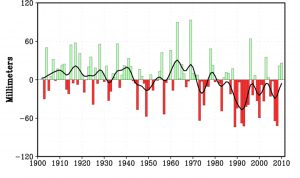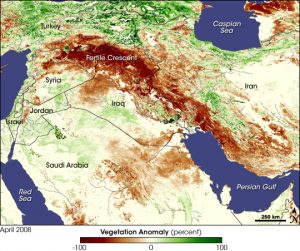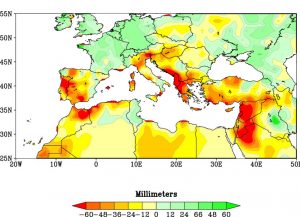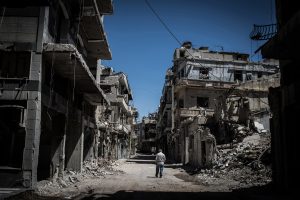
When we hear about Syria in the news we are repeatedly disheartened.
We see a country in shambles, bombs exploding, injured children… The media discusses the increased political tensions in the area and the threat of international war. The world is trying to find homes for millions of refugees fleeing the country, and children are experiencing war before a childhood.
It makes us think, “What caused this?”
If we take a step back and look at the causes of the Syrian Civil War. Climate change, in some part, played a role.
The Story of Syria
In 2006/2007, the Fertile Crescent (FC) region of the Middle East, a region where agriculture and livestock have thrived for thousands of years, underwent a shift in weather patterns that caused rainfall to decrease.

As a result, the area experienced a three-year drought worse than any previously recorded. The drought increased water scarcity, dampened agricultural production, and drove widespread livestock failure.

The failure of crops and livestock caused Syrian food prices to skyrocket and forced Syria to import crops that once provided income for farmers and economic growth for the country. The continued loss of livelihood by farmers and pastoralists pushed millions to migrate into cities and camps outside of Syria’s urban areas.
Populations of Syrian urban areas increased by more than 50% over the span of 8 years, thus placing pressure on the urban areas’ limited resources.
The government neglected to act and create economic and political responses to the growing resource pressures caused by the ramifications of the drought and pre-existing vulnerabilities in Syria (including unemployment, poor agricultural policy, inequality within urban areas, and unsustainable water and land use).
Social unrest against the government followed. In response, the government of Bashar al-Assad attempted to silence protest, which in turn, spurred a rebellion that led to the ongoing six-year civil war.
The key question is, “Did climate change spark the drought, or was it due to a naturally occurring trend?”
To answer this question, I spoke to Dr. Colin Kelley, a leading scientist in the field of climate-conflict debate in Syria, about the specific aspects of Syria that made it vulnerable to the drought.
Is Climate the Cause?
In his study, Dr. Colin Kelley examined the severity of the drought compared to the region’s climatic history. Kelley used climate model simulations and observations to determine that, had it not been for the recent warming and precipitation trends in the FC, it is unlikely that natural trends caused the most recent drought in the region. Rather, the naturally occurring drought was made worse by human-induced climate change.

However, other nations were negatively affected by the drought alongside Syria. What made Syria so vulnerable?
Kelley and another study by Peter Gleick found that unsustainable agricultural policies created by Syria’s government heavily contributed to the consequences of the drought. These policies sought to heavily increase agricultural production through intensified water use and land redistribution.
Rain-fed crops dominate the region, and farmers rely not only on groundwater, but also on water from the Euphrates and Tigris Rivers and their tributaries. Groundwater accounts for more than half of water used for irrigation. Many Syrian farmers relied on highly inefficient flood irrigation practices, which caused groundwater levels to nearly deplete and production costs to increase.
This dependence on rainfall for agriculture and exploitation of land and hydrological systems left Syria particularly vulnerable to the ramifications of the drought.
Overall, poor water management practices, decisions, and policies combined with the intensity of the drought spelled out disaster for Syria.
Syria’s policies failed to adapt in time. To assess what can be learned from Syria, I asked Dr. Colin Kelley about adaptation measures future conflict-prone regions can implement in the face of climate change.
What Can We Learn From Syria?
Dr. Colin Kelley warns, “Every region and nation is different with respect to its overall vulnerability.”
When asked what conflict-prone areas can do, Kelley claims, “The specific ways in which each nation can adapt differ. For some it might be better agricultural choices or irrigation practices, for others, it might be better governance or environmental policy, or more often it will be some combination of factors.”
When looking towards the future, Kelley says, “In general, most places need to have some sort of long-range sustainability goals with respect to water and agriculture, in addition to short-term solutions. Of course, many vulnerable places are economically challenged, making adaptation efforts difficult. Population increase and groundwater decline are key factors to consider.”
The Pentagon labels climate change as a “threat multiplier” regarding its influence on conflict. Future conflicts will need to be assessed from all standpoints: political, economic, social, and now, climatic.
In the face of these potential consequences of climate change, it is better to be proactive than reactive. Better research and understanding of the causes of conflict is needed.

What can we do?
The case of Syria is an example of a possible outcome when climate change mixes with the pre-existing political instability and economic divides of a nation.
Kelley adds, “Syria may be thought of as a worst-case scenario, but it does serve as an example of the urgent need for better water and agricultural policy, but we should be cautious about extrapolating what occurred there to other nations.”
In the meantime, we need to think differently about the causes of conflict. Many organizations are assessing the debate around climate change’s role in the onset of conflict. Here are some organizations currently working to research and understand this connection, especially in Syria:
- The Center for Climate and Security
- The American Security Project
- Truman National Security Project
- Wilson Center – Environmental Change and Security Program
- U.S. Navy’s Task Force Climate Change (TFCC)
- Global Military Advisory Council on Climate Change
- Age of Consequences Film
We also need to think differently about our own actions and how we may be contributing to these global warming trends.
Here is what we can do:
- Better understand the crisis in Syria and tell others
- Contact your elected local officials or the U.S. Department of State and encourage them to take the action you want them to
- Work to reduce your carbon footprint
